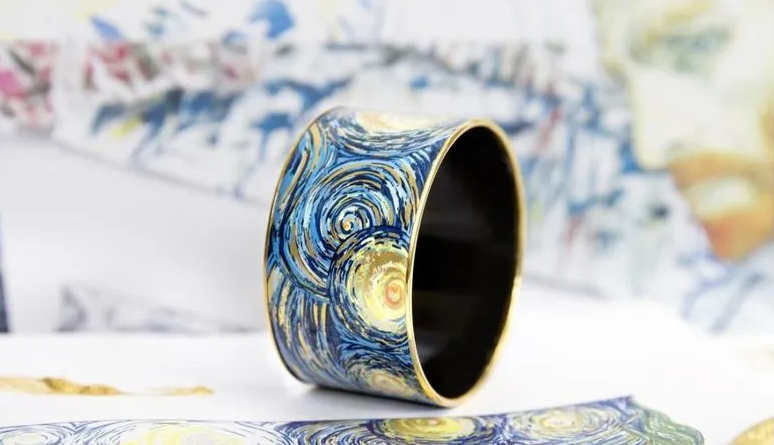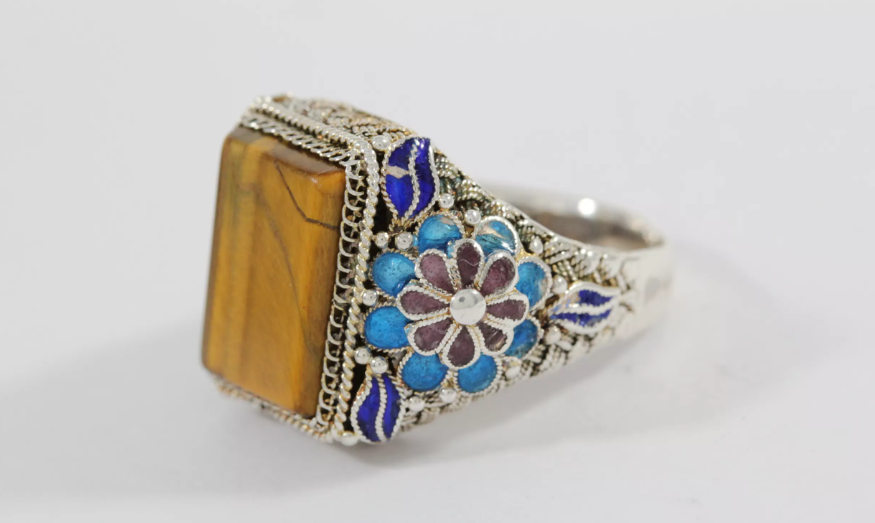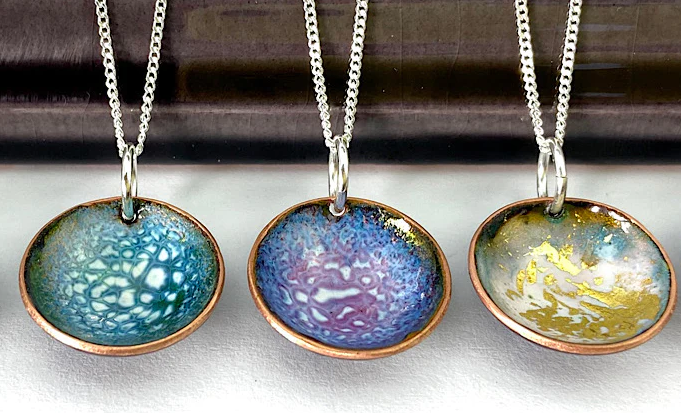Jewelry is more than just an accessory. It often carries sentimental value, represents significant life milestones, and, for many, serves as an expression of personal style.
Among the varied materials used in jewelry-making, enamel holds a special place for its vibrant colors and intricate designs. But as we indulge in the beauty of enamel jewelry, a common concern arises: Does it rust?
In this article, we will delve deep into the properties of enamel, understand its composition, and finally answer the pressing question about its susceptibility to rust.
Understanding Enamel in Jewelry
Enamel, in the context of jewelry, is a glass-like substance that is melted onto metal to produce vibrant and intricate designs. It’s a technique that involves fusing powdered glass to a substrate (usually a metal) by firing, usually between 750 and 850 degrees Celsius. The powder melts, flows, and then hardens to a smooth, durable vitreous coating on metal.
Historical Use of Enamel
The use of enamel in jewelry dates back thousands of years, spanning various cultures and epochs.
Ancient Egyptians, for instance, were known for their use of enamel on stone and pottery, and this technique was later adopted and refined by the Chinese, Greeks, Celts, and even the Byzantine Empire.
During the Middle Ages, the art of enameling was particularly popular in the Byzantine Empire and Islamic areas. By the time of the Renaissance, enameling had spread throughout Europe, with each region developing its own distinct style and techniques.
The art of enameling reached its pinnacle during the Art Nouveau period (late 19th to early 20th century), where renowned artists and jewelers like René Lalique, Carl Fabergé, and Louis Comfort Tiffany incorporated enamel in their pieces, creating timeless masterpieces that are still celebrated today.
The Beauty of Enamel in Jewelry
Enamel has a unique allure and charm when used in jewelry. It allows for the creation of a diverse palette of colors that are often hard to achieve with gemstones alone.
Vibrancy and Luster: Unlike other materials, enamel retains its vibrancy and luster over time, ensuring that pieces remain as captivating as the day they were crafted.
Versatility: Enamel can be applied in a range of techniques, from cloisonné (where fine wires are used to delineate design areas) to champlevé (where recesses are carved into the metal and then filled with enamel), granting artists significant creative freedom.
Depth and Dimension: The translucent nature of some enamels can create a sense of depth, making designs seem three-dimensional and lending an almost ethereal quality to pieces.
Durability: Properly fired enamel is durable and resistant to wear, ensuring that the beauty of the jewelry piece lasts.
Unique Patterns: With enamel, jewelers can create intricate patterns, portraits, and landscapes, turning a simple jewelry piece into a storytelling artifact.
What Causes Rust?
Rust is more than just an aesthetic blemish on metals; it’s a natural chemical process that can degrade the integrity of iron and its alloys. To truly understand whether enamel jewelry can rust, it’s crucial to grasp the underlying causes of rust.
Oxidation of Iron: At its core, rust is the result of a chemical reaction where iron reacts with oxygen in the presence of moisture to produce iron(III) oxide, commonly known as rust. The chemical equation for this process is:
4Fe + 3O2 → 2Fe2O3
The brownish-red layer that we often see on neglected iron items is the visible manifestation of this reaction.
Factors Contributing to Rusting
Presence of Water: For rusting to occur, there must be moisture present. This doesn’t necessarily mean liquid water; even high humidity in the air can be enough to facilitate rusting.
Oxygen: As shown in the chemical equation, oxygen is a necessary component of the rusting process. Without oxygen, iron won’t rust.
Salts: Salts can significantly speed up the rusting process. They act as electrolytes that encourage the movement of electrons, thereby intensifying the rate of oxidation. This is why iron or steel structures near the sea (where the air is salty) rust faster than those in drier, inland areas.
Rusting vs. Tarnishing:
Rust is specific to iron and its alloys, like steel. However, many metals can undergo a similar deterioration process. When metals like silver, copper, or brass react with elements in their environment, they can tarnish.
Tarnish is not the same as rust, but it’s a similar concept. While rust gives a reddish-brown coloration to iron, tarnish can manifest in various colors depending on the metal and the reacting agents. For instance, silver tarnishes black and copper can tarnish to a green patina.
Enamel and Its Resistance
Let’s delve into the characteristics of enamel and its ability to resist degradation.
The non-metallic nature of enamel
Enamel, in the context of jewelry, is a glassy substance melted onto metal to produce a decorative or protective coating. Unlike metals, which may corrode or oxidize over time when exposed to air or moisture, enamel boasts a non-metallic composition. This means it inherently lacks the properties that make materials, like iron, susceptible to rust. By its very nature, enamel does not rust.

Enamel as a Protective Layer
Beyond its decorative purpose, enamel serves as a protective shield for metals. When applied correctly:
Barrier Against Moisture and Air: Enamel forms a continuous, impermeable layer over the metal, preventing moisture and air – the primary culprits of rust – from coming into direct contact with the metal surface.
Chemical Resistance: Enamel resists many chemical reactions that might cause other materials to degrade. This property helps protect the underlying metal from corrosive agents present in the environment.
Physical Barrier: Being a hard substance, enamel also provides a degree of physical protection against scratches or minor abrasions that might compromise the integrity of the metal underneath.
Limitations of Enamel’s Protective Qualities
However, like all materials, enamel isn’t without its limitations:
Chipping and Cracking: While hard, enamel can chip or crack if subjected to substantial impact or bending. Once the enamel is compromised, the metal beneath becomes exposed, making it vulnerable to environmental factors that can lead to rusting.
Wear Over Time: With repeated wear and exposure to elements, the enamel coating might thin out, reducing its effectiveness as a protective barrier.
Imperfect Application: If the enamel isn’t uniformly applied or if there are gaps in the coating, those spots become potential entry points for moisture and air, allowing the metal underneath to corrode.
While enamel provides significant protection against rusting, handling and storing enamel-coated jewelry with care is essential to ensure its longevity. Regular checks for chips, cracks, or wear can go a long way in ensuring that the metal beneath remains unharmed and rust-free.
Underlying Metal Matters
In the world of enamel jewelry, the aesthetic charm and radiant colors often draw our attention. However, beneath the shimmering enamel lies the base metal, which plays a crucial role in determining the durability and resistance of the jewelry to corrosion and rust. So, does enamel jewelry rust? The answer largely depends on the underlying metal. Let’s delve deeper into how different metals react and why the quality of the enamel’s application matters.
Common Metals Used in Enamel Jewelry
1. Copper: Copper has a rich jewelry-making history due to its malleability and beautiful reddish-brown hue. However, it’s essential to note that while copper doesn’t rust, it is prone to tarnishing. Over time, when exposed to air and moisture, copper can develop a greenish patina. Though many appreciate this vintage appearance, others might need help finding it appealing.
2 Silver is another beloved metal in jewelry-making, silver is known for its lustrous shine and versatility. Like copper, silver doesn’t rust but can tarnish, turning a darker, blackish color. Periodic cleaning and proper storage can help maintain its original shine.
3. Iron or Steel: These metals are less commonly used for enamel jewelry, mainly because of their susceptibility to rust. Iron and steel, when exposed to moisture and air, can oxidize, leading to rust formation. This becomes particularly problematic if the enamel coating chips or cracks, exposing the metal beneath.
Importance of Quality Craftsmanship
Even the most rust-resistant metals can become vulnerable if the enamel coating isn’t applied properly. Quality craftsmanship is pivotal in ensuring that the enamel covers the metal thoroughly and uniformly.
A well-applied enamel layer is a protective barrier, preventing air and moisture from reaching the metal. This not only helps in preserving the shine and appearance of the jewelry but also extends its lifespan.
However, accidents can happen, and enamel can chip or crack due to impact or regular wear and tear. Therefore, it’s essential to handle enamel jewelry with care and, if possible, keep them stored in a dry and soft environment when not in use.
Caring for Enamel Jewelry
Enamel jewelry is a unique blend of metal and glass, creating vibrant and lasting colors that make these pieces especially treasured. However, as with all jewelry, enamel pieces need particular care to keep them in prime condition. Here are some expert recommendations to maintain the luster and integrity of your enamel jewelry:
Recommendations to avoid chipping or cracking the enamel
1. Handle with Care: Always handle enamel jewelry gently. Avoid dropping the jewelry on hard surfaces, as this can cause chipping or cracking of the enamel.
2. Avoid Extreme Temperatures: Rapid temperature changes can cause the enamel to crack. Do not expose the jewelry to direct sunlight for extended periods or leave it in very cold places.
3. Stay Chemical-Free: Keep your enamel jewelry away from chemicals. This includes avoiding contact with perfumes, lotions, or household chemicals which can damage the enamel’s finish.
4. Remove During Strenuous Activities: To prevent any physical harm to your enamel jewelry, remove them during activities like gardening, exercising, or any other tasks that may involve rough contact.
5. Layer Wisely: If you wear multiple pieces of jewelry, ensure the enamel pieces are not rubbing against other harder materials, which could cause scratching or chipping.
Storage Tips to Prevent Exposure to Excess Humidity or Moisture
- Dry Location: Store your enamel jewelry in a cool, dry place. Excess humidity or moisture can damage both the metal and the enamel over time.
- Individual Storage: Use separate pouches or compartments to store each piece of enamel jewelry to avoid scratching or tangling with other items.
- Silica Gel Packs: Consider placing a silica gel pack inside your jewelry box. These packs absorb moisture and can help to keep the environment dry.
- Regular Checks: If you store your enamel jewelry for extended periods, check them occasionally to ensure there isn’t any condensation or signs of moisture.

Cleaning Methods that are Gentle on Both the Enamel and the Underlying Metal
1. Mild Soap and Water: The safest way to clean enamel jewelry is with lukewarm water and mild soap. Use a soft cloth or a gentle brush to clean away dirt, then rinse with clean water and pat dry with a soft towel.
2. Avoid Harsh Chemicals: Never use acidic or abrasive cleaners on enamel jewelry, as these can damage the enamel’s surface or cause discoloration.
3. Professional Cleaning: If your jewelry becomes heavily soiled or you need clarification on cleaning it at home, consult a professional jeweler with experience with enamel pieces.
4. Polishing the Metal: If the metal part of your jewelry needs polishing, use a soft cloth and be careful not to scratch the enamel.
Conclusion
In addressing the question of whether enamel jewelry rusts, it’s essential to distinguish between the components of the jewelry piece. Pure enamel, which is a type of glass, does not rust. It is non-metallic and thus not susceptible to the oxidation process that results in rust. However, the metal upon which the enamel is often applied can be vulnerable to rust, depending on its composition.
For example, if the enamel is applied to iron or certain types of steel, these metals can indeed rust if exposed to moisture over time. But, when enamel is adhered to non-rusting metals like gold, silver, or stainless steel, the overall piece will be more resilient against rust, with the enamel serving as an additional protective layer.
Therefore, when purchasing or caring for enamel jewelry, it’s crucial to be aware of the underlying metal. Proper storage, cleaning, and occasional inspection can help ensure the longevity and beauty of enamel jewelry, even if the base metal is prone to oxidation. Always ensure that your pieces are dry and stored in a low-humidity environment to reduce the potential for rust and other types of damage.



